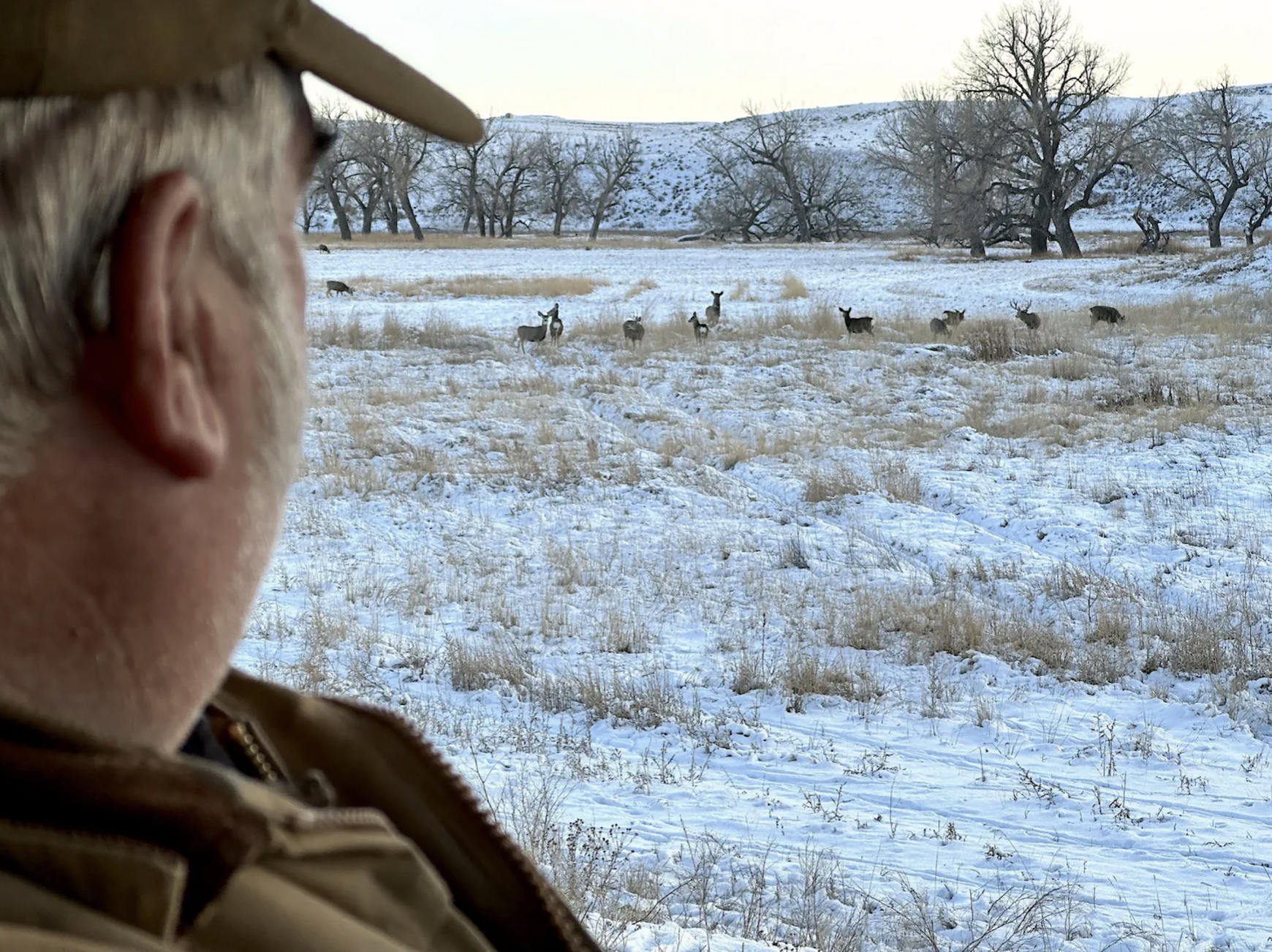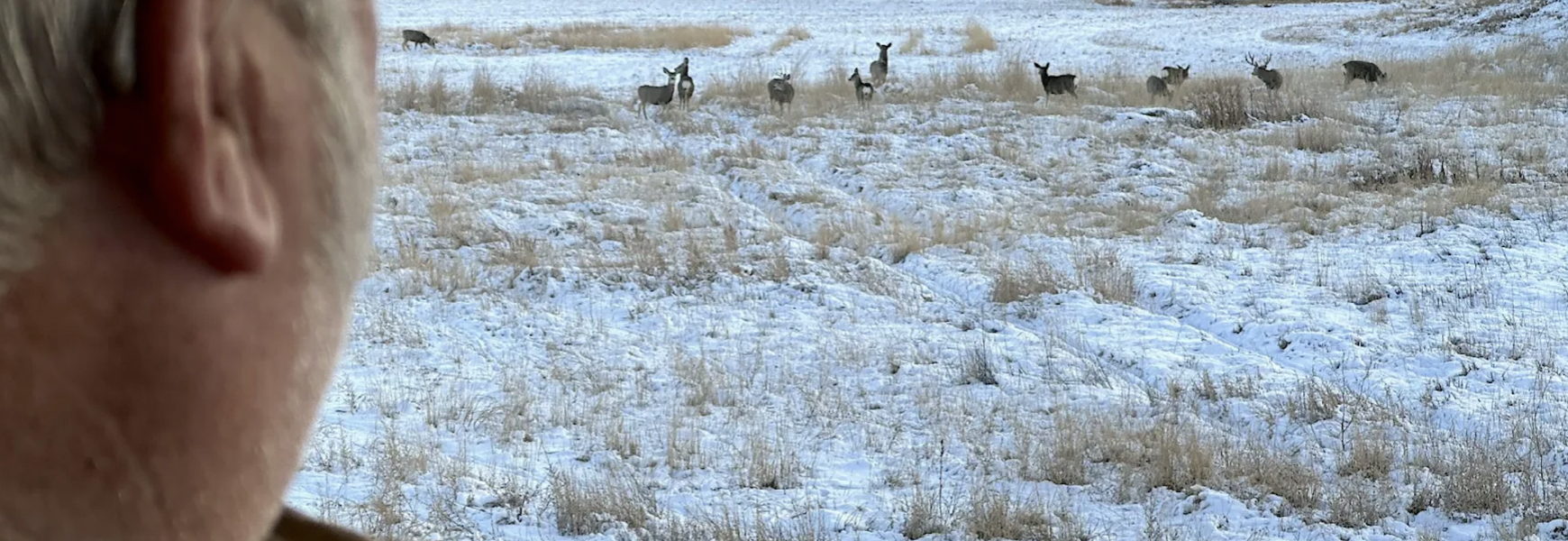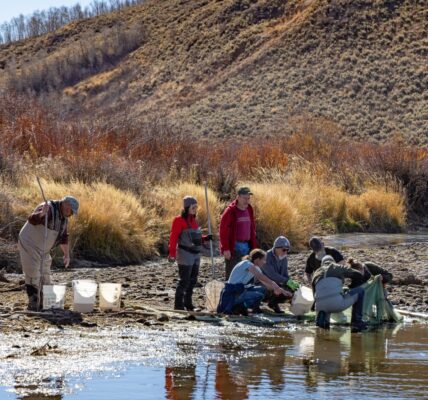
• East of the Bighorns, deer are being stressed and depressed by a dizzying array of factors, from drought to disease to energy development. Now, their numbers are plummeting.
By Mike Koshmrl, WyoFile.com
POWDER RIVER BASIN — The dead does’ whereabouts hinted at a brutal death.
Clipped or creamed by a vehicle cruising Interstate 90 toward Gillette, her battered remains lay frozen in the bottom of a roadside ditch.
A few hundred yards to the east, another mule deer decomposed slowly. Evidently, both highway casualties were too caked in snow for the Wyoming Department of Transportation cleanup crews to notice.
WYDOT crews know the drill well here, where the four-lane interstate cuts across northeast Wyoming’s high plains. Along one 42-mile stretch of I-90, the state agency recorded 994 road-killed deer over a recent 10-year period. Others — potentially these two frozen does — are never found and logged.
Death is inevitable for the mule deer that cross the interstate here in the Powder River Basin with any frequency.
“What we found was none of the animals figured it out,” said Hall Sawyer, an ecologist who studied three segments of the Powder River and Pumpkin Buttes mule deer herds for the Wyoming Game and Fish Department.
“It’s just too dangerous,” he said. “They tried a few times and they’re dead.”
Had the two does steered clear of I-90 completely, they would have been 2.5 times more likely to survive Sawyer’s study period. But all evidence suggests they still would have faced a rough go at life in modern northeast Wyoming.
Survival rates of the 114 collared adult female mule deer Sawyer studied in the Powder River and Pumpkin Buttes herds were “alarmingly low,” ranging from 66% to 79% annually, below the range-wide average of 85% and up. More than half the animals died, primarily from collisions and disease, over the three-year study.
“I’ve never had a deer collaring study where that many deer died,” Sawyer said. “It’s sad.”
Not enough fawns are being born to hold the line. The Pumpkin Buttes Herd has experienced seven straight years of decline. In November, the Game and Fish Commission approved a 31% reduction in the Pumpkin Buttes population goal, slashing it to 9,000 animals. The Powder River Herd hasn’t fared any better. It’s on a “long, slow downward trend,” according to wildlife managers who reported they’re likely to soon slash the herd’s now-unreachable 45,000-deer objective for the second time in a decade.
Under siege in every direction
There’s no simple explanation or single culprit for why mule deer in these two northeast Wyoming herds have struggled so mightily, according to researchers and game managers. They’ve fared especially badly, even relative to a species tanking generally in the Equality State: Numbers of the bounding, big-eared native deer have fallen by more than half since the turn of the century.
Tim Thomas has worked out of Game and Fish’s Sheridan Region for just as long, and he’s watched as one stressor after another has piled on, collectively inhibiting the landscape’s ability to support mule deer.
“There’s been a lot of factors over the last 25 years to get us where we are today,” said Thomas, the region’s wildlife management coordinator.
Rusty Bell, a taxidermist and former Campbell County commissioner who sits on the Wyoming Game and Fish Commission, doesn’t believe rank-and-file biologists and wardens could have prevented the decline. Odocoileus hemionus is notoriously unadaptable and simply incapable of adjusting to the habitat disruptions and other forces that have descended on the Powder River Basin, he said.
“They’ve been hit by all kinds of different things: 8, 10, 12 different things happening to them,” Bell said from a Gillette steakhouse.
Bell and Thomas verbalized, and Sawyer’s report detailed, many of those factors. They are, in no particular order:
A prolonged drought struck northeast Wyoming for the first seven years of the century, desiccating rangeland the deer depend on. Withered, sparser shrubs and grasses reduced how many deer the landscape could support, and led to thinner females less likely to successfully rear fawns.
Around the same time, the basin’s coalbed methane industry boomed, carving up the private-land-dominated landscape with some 30,000 wells, thousands of miles of roads, pipelines, powerlines and other industrial infrastructure.
The industrialization likely displaced the easily disturbed deer, and killed them in other ways, too. A “significant” number of deer were hit and killed by industry vehicles during the height of the coalbed methane boom, Thomas said, especially because the rigs were headed to and from drilling sites at dawn and dusk.
Five of the collared deer along I-90 died from a virulent condition called epizootic hemorrhagic disease. Those deer, Sawyer’s report states, likely contracted EHD at coalbed methane discharge reservoirs that concentrate the vectors: biting midges.
Then there’s chronic wasting disease, an incurable and always-fatal affliction similar to mad cow disease. Deer in the Powder River Basin aren’t being devastated by CWD to the degree some other Wyoming herds are, but 11% of the deer deaths in Sawyer’s study were attributed to CWD (and that’s a minimum, because only 60% of the dead deer were tested).
Most of the CWD-positive mule deer died in a population extending east from Lake De Smet near Buffalo. It’s suspected that the sickened mule deer in the area — the only migratory population Sawyer detected — got the prion disease from mixing with whitetail deer, which tend to carry CWD at higher rates.
Whitetail in the region generally are “doing really well”, Thomas said. There’s been scant research looking at interspecies competition between the two native deer species, but they often share habitat, and whitetail are thriving while mule deer spiral downwards.
Elk in the area have thrived, too. Research in southwest Wyoming’s Little Mountain area found a clear negative relationship between mule deer fat levels — a big barometer of health — and proximity to elk herds.
There’s less viable habitat available for mule deer to share with the other species, too. Sheridan, Buffalo and Gillette have all sprawled outwards: “There’s numerous subdivisions going back towards the Bighorns,” Thomas said, “and there’s rural development.”
The health of remaining rangeland is being depleted by the incursion of invasive annual grasses. Cheatgrass, Japanese brome and ventenata are all increasing at the expense of native grasses, Thomas said, and the newcomer exotics don’t offer much nutritional value for mule deer.
Taken together, the pressures have created a world with a fraction the number of deer that there were a decade ago.
Rancher’s eye view
Cattleman Gene Mankin has watched the decline play out in slow motion on his 50,000-acre ranch south of the Pumpkin Buttes. A Powder River tributary, Cottonwood Creek, cuts through the hilly, sagebrush-studded property, and he’s spent 44 years taking drives down the draw to count deer and look for other wildlife.
The current decline, he said, gathered steam during an extreme drought in 2021 and 2022. He counted 128 mule deer in a meadow along the drive on the front end of the drought, but his tally dwindled to 32 by the time it was over.
“They disappeared,” Mankin said. “And we never saw any carcasses.”
The collapse was concerning enough to the Gillette native that he put a stop to commercial hunting on the ranch.
“They kept taking too many — more than I wanted,” he said.
Making the rounds in his pickup in late November, Mankin still saw some mule deer sprinkled here and there — at least a few dozen. He also saw pronghorn, elk and a few far-off whitetail. The latter two species were absent in that country until around 20, 25 years ago, he said.
Another newcomer to Mankin’s 80 sections in southwestern Campbell County was a network of roads — built for free by coalbed methane drillers who have leased the land. Out on the drive, he gestured toward the horizon to the north.
“That’s about two miles. It’d take you 45 minutes to clatter up there in a pickup,” Mankin said. “Now we can be there in 12 minutes.”
Uranium mines also dotted the property.
“We’re fortunate,” Mankin said, “because of the extra income.”
Mankin doubts the drilling and mining contributed to the deer decline. “Like anything,” he said, “they get acclimated to it.”
Steve Adami, who ranches east of Buffalo, is another landowner who’s been struck by the Powder River Basin’s mule deer collapse. The Johnson County man described the change as “almost eerie.”
“In places where you used to see hundreds of deer,” he said, “you might see 10 or 15 now.”
Adami’s 13,000 acres have not been leased to energy producers.
“And we don’t have any deer either,” he said, “so it isn’t just coalbed methane, but they darn sure don’t help.”
It’s tough to say exactly what role industrialization of the Powder River Basin played in making the region less suitable for mule deer. Although dotted by state and federal land ownership, the area is dominated by private property. The Bureau of Land Management did conduct an environmental impact statement to assess CBM’s effects on almost 8 million acres of northeastern Wyoming, but there were no dedicated studies geared toward gauging what widespread drilling would do to deer.
“We have not done any research over here,” Thomas said.
But the habitat choices of collared deer in Sawyer’s study suggest there’s a clear effect, according to a recent Game and Fish memo. Those deer avoided disturbance and development, while occupying more wild landscapes, the GPS data showed.
Declining in the dark
Bell, the Game and Fish Commissioner, believes it’s high time to shift some resources toward better understanding the plight of mule deer in places like the Powder River Basin.
“We have the most-researched herd in the world, over in the Wyoming Range,” he said, “but you don’t have that research in a lot of other places. We’ve done some studies in these areas, but you don’t have that 20-year baseline.”
Game and Fish has ramped up monitoring efforts. The state agency is well into its 15-year-old Wyoming Mule Deer Initiative, intended to improve habitat, adjust hunting seasons and develop science to conserve deer herds throughout the state.
Or at least attempt to conserve them. Mule deer numbers in Wyoming have continued to decline, according to Doug Brimeyer, deputy chief of the Game and Fish’s wildlife division.
The statewide population estimate penciled out to 242,500 mule deer after the 2022 hunting season, 49% below the goal of 473,600 animals. Post-hunt 2023 figures aren’t yet available, but they’re likely to be lower yet again following the worst winter in generations, especially for western Wyoming deer.
And population objectives keep shrinking across the state.
Brimeyer presented the Game and Fish Commission with the proposal to slash the Pumpkin Buttes Herd’s target size in November.
Going into the adjustment, the herd numbered an estimated 4,700 animals, just 36% of the 13,000-deer goal. Even after moving to a 9,000-deer target, that still left Game and Fish with only 52% of the desired number of deer.
The neighboring Upper Powder River mule deer herd (different from the Powder River Herd in Sawyer’s study) experienced an even more dramatic change. There, biologists were tallying just 26% of the 18,000-animal goal. The commission slashed the objective in half, so now the herd’s roughly half the targeted size.
Not a single outfitter nor any member of the public formally weighed in. The Wyoming Game and Fish Commission received no written comments, and only Brimeyer stood at the mic during the November meeting.
“Given the status of mule deer in Wyoming and the changes we’re seeing in places like Powder River, it’s kind of surprising that people didn’t provide a little bit more opinion,” Brimeyer told WyoFile.
The state agency has already taken the biggest step in its power to help both herds, ending all doe and fawn hunting. The only mule deer that can be hunted — bucks — do not have any bearing on the trajectory of the populations.
Bell, who did speak up during the commission meeting, worries that the hunting community and Wyoming residents generally don’t grasp the significance of the long-term declines in mule deer.
“Because you still see a lot around town,” Bell told WyoFile. “You still see deer.”
Residents’ baseline expectations for what’s a normal number of deer have shifted. Adami, the Buffalo-area rancher, recalled how many more mule deer he once saw when he traveled I-90 to Gillette as a high schooler.
“You’d hit the brakes 10 times with near misses for deer on the interstate,” he said.
Fast forward half a century and those that remain are still getting struck — at a rate of roughly 100 a year, according to WYDOT data cited in Sawyer’s research.
Muley Fanatic Foundation co-founder and southwest Wyoming resident Josh Coursey has reviewed Sawyer’s study. He wasn’t surprised.
“Mule deer are taking it on the chin from multiple factors everywhere you turn,” he said.
Coursey and other mule deer advocates “want to draw a line in the sand,” he said.
“We can’t do this anymore, we’ve got to do something,” Coursey said. “If we continue to let this go on and persist, we know these effects and impacts to deer are getting to the point where they might be irrecoverable.”
Mule deer populations have been lost before, according to Jim Heffelfinger, an Arizona ecologist who chairs the Western Association of Fish and Wildlife Agencies’ Mule Deer Working Group. Closely related black-tailed deer have been extirpated from the Central Valley in California, he said.
Mule deer throughout the West had a rough go in the 1990s, Heffelfinger said, but rangewide the species is now pretty stable. There are exceptions: States and regions where habitat mule deer depend on are slowly declining and under siege from one factor or another.
“There’s no doubt that a lot of our grassland and a lot of shrublands were way more productive [for mule deer] in the 1950s than they are now,” Heffelfinger said. “It’s something that’s hard to point to and say, ‘Look at that problem,’ because it’s just such a slow, long-term change. But it’s real and it’s pretty widespread.”
In the Powder River Basin, the effects of those long-term changes are on full display.
WyoFile is an independent nonprofit news organization focused on Wyoming people, places and policy.





